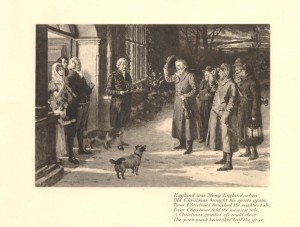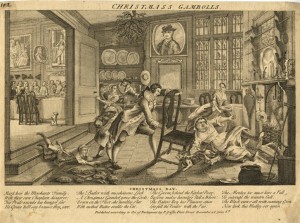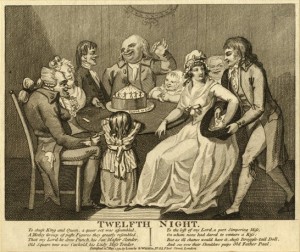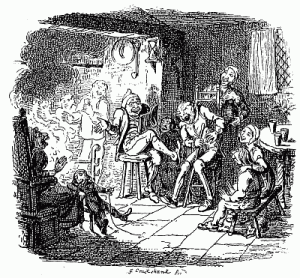On 23 December 1826, the author of an anonymous piece entitled ‘Christmas customs’ and published in The Mirror thus reflected:
It is a season the most cheerles; the clouds and vapours increasing, and the chilliness of winter’s near approach, accelerating not the most enlivened ideas, we have the greater relish for Christmas gambols.
The article included reminiscences about ‘the merry and generous practices of our “gone-by” brethen’ and an explanation of the origins of waits, carol-singing, mince pies, and the use of evergreens, such as mistletoe. The Mirror‘s contributor cited the same verses that appear in this Christmas card after the Victorian painter Frank Dadd, who casts a nostalgic eye back to the eighteenth century:
In Douce’s prints, however, Christmas are boisterous, noisy, and messy. His repertory of ‘Christmas customs’ includes this fight under the mistletoe:
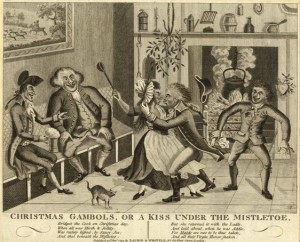
Christmas gambols, or a kiss under the mistletoe, 1794, etching published by Laurie & Whittle (Ashmolean Museum, Oxford)
Practical jokes involving the scalding of the cat:
And some subreptitious flirting around the Epiphany cake:
The kind of prints in which Douce was interested rendered his collection a very useful resource for his friend William Hone, whose Every-day book was published as a sort of almanac for 1825-6. Hone’s work provided information ‘on antiquarian lore and popular culture’ for each day of the year, as Kyle Grimes notes in his introduction to the electronic edition.
Douce is mentioned twice in Hone’s essay on Christmas Eve, first as the translator of an Anglo-Norman carol that Hone reproduced and, secondly, as the source of ‘a specimen of the carol sung by the shepherds, on the birth of Christ, in one of the Coventry plays’, which had been published in his Illustrations of Shakespeare.
Hone also referred to the woodcuts that often illustrate carol sheets in a few evocative lines that could have been written by Dickens who, according to Grimes, ‘owned and annotated a copy’ of the Every-day Book:
In the rage for “collecting” almost every thing, it is surprising that “collectors” have almost overlooked carols, as a class of popular poetry. To me they have been objects of interest from circumstances which occasionally determine the direction of pursuit. The wood-cuts round the annual sheets, and the melody of “God rest you merry gentlemen,” delighted my childhood; and I still listen with pleasure to the shivering carolist’s evening chant towards the clean kitchen window decked with holly, the flaring fire showing the whitened hearth, and reflecting gleams of light from the surfaces of the dresser utensils.

